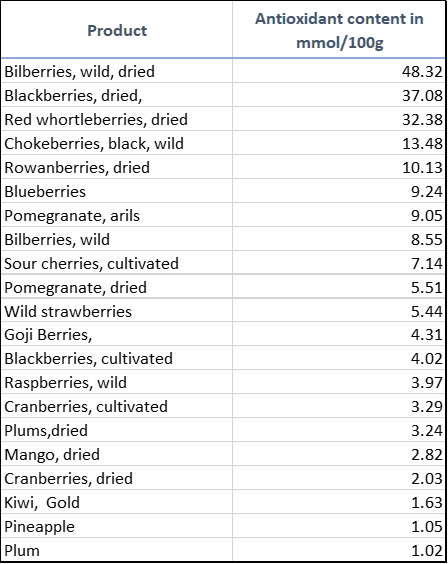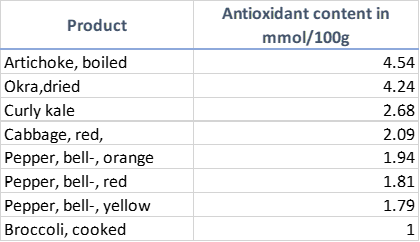Natural Antioxidants: Sources, Benefits and Applications

This post is also available in:
This post is also available in:
![]() Français (French)
Français (French) ![]() Deutsch (German)
Deutsch (German) ![]() हिन्दी (Hindi)
हिन्दी (Hindi) ![]() Ελληνικά (Greek)
Ελληνικά (Greek)
Antioxidants: Sources and Classification
Natural antioxidants are found in a wide variety of plant-based foods, including fruits, vegetables, nuts, seeds, and herbs [1, 2]. They are classified into several categories based on their chemical structure and properties. Reportedly, here are some common sources and classifications of natural antioxidants [3, 4, 5]:
- Polyphenols: Polyphenols are a large and diverse class of antioxidants found in many plant-based foods, including fruits (berries, apples, and citrus fruits), vegetables (spinach, kale, and broccoli), nuts (almonds and walnuts), and tea (green tea and black tea). They are further classified into subclasses such as flavonoids (found in celery, parsley, red peppers, chamomile, mint and ginkgo biloba), stilbenes (found in grapes’ skin, mulberries, peanuts, and red wine), and phenolic acids (). Reportedly, flavonoids include Luteolin, apigenin and tangeritin while phytoalexins resveratrol and piceatannol, are recognized as from stilbenes. Phenolic compounds include Protocatechuic acid (PCA), p-hydroxybenzoic acid (PHBA), Vanillic acid, Caffeic acid, p-Coumaric acid, Ferulic acid, Syringic acid, quercetin, catechins, anthocyanins, the consumption of which has been associated with achieving health benefits.
- Carotenoids: Carotenoids are pigments that give many fruits and vegetables their orange, yellow, and red colors. They are found in foods such as carrots, sweet potatoes, tomatoes, and spinach.
- Vitamins C and E: These vitamins are powerful antioxidants that are found in many fruits and vegetables, as well as in nuts and seeds. Vitamin C is found in citrus fruits, berries, and leafy green vegetables, while vitamin E is found in nuts, seeds, and vegetable oils. Based on their solubility, they can be categorized as water-soluble or lipid soluble. For example, Vitamin C is water soluble while Vitamin E and carotenoids are fat-soluble antioxidants.
- Terpenoids: Terpenoids are a large and diverse group of natural compounds found in many plants, including herbs (rosemary, thyme, and sage), spices (cinnamon and ginger), and fruits (such as oranges and lemons).
- Alkaloids: Alkaloids are a group of natural compounds found in many plants, including tea, coffee, cocoa, and certain fruits and vegetables. They have been shown to have antioxidant and anti-inflammatory properties.
- Trace elements (Se, Zn, Cu, Mn, Fe): Trace minerals such as selenium, iron, copper, zinc, and manganese also play critical roles in the maintenance of the body’s antioxidant defense system. Foods highest in these elements are: ready-to-eat cereals, mixed dishes, meats, nuts, beans/peas fish, poultry, and dairy desserts.

Which Foods are high in antioxidants?
Assuming that there is a relationship between energy intake and the need for dietary antioxidants, dietary antioxidant needs could be estimated upon dietary energy intake. For an individual consuming 2500 kcal per day, AOC needs are estimated to be 11.5 mmol. Table 1 below displays a sample of foods with high antioxidant content. However, as mentioned above, many fruits and vegetables contain antioxidants and should be consumed daily. Examples of fruits with antioxidants include: Berries, known as fruits with highest antioxidants as compared to other fruits. Similarly, dried fruits contain more antioxidants than fresh fruits but they are higher in energy and sugars. A lot of antioxidants are also included in coffee, green tea and cocoa.
Table 1: Examples of fruits with high antioxidant contents (mmol/100g) [13]

Table 2: Examples of vegetables with high antioxidant contents (mmol/100g) [13]

Which are the health benefits of antioxidant usage?
Antioxidants are naturally occurring compounds that play a crucial role in protecting the body from the damaging effects of free radicals [5, 6]. Free radicals are unstable molecules that can cause damage to cells and contribute to the development of a range of health problems, including cancer, heart disease, and neurodegenerative disorders. Antioxidants work by neutralizing free radicals and preventing them from causing harm to the body. There are a variety of different types of antioxidants, including vitamins C and E, beta-carotene, and selenium, among others. These nutrients are found in a variety of foods, including fruits, vegetables, nuts, seeds, and whole grains. Research has shown that consuming a diet rich in antioxidants can offer several health benefits. For example, studies have suggested that a diet high in antioxidant-rich foods may help to reduce the risk of cancer [7]. This is thought to be due to the ability of antioxidants to neutralize the free radicals that can damage DNA and lead to the development of cancer cells. Additionally, antioxidants have been shown to have a positive impact on heart health. Research has suggested that consuming a diet rich in antioxidants may help reduce the risk of heart disease by improving cholesterol levels, inflammation, and blood vessel function [8]. Antioxidants may also play a role in protecting against neurodegenerative disorders such as Alzheimer’s disease. Studies have suggested that the damage caused by free radicals is a contributing factor in the development of these conditions and that antioxidants may help to protect against this damage. Additionally, lycopene which can be found in red fruits and vegetables such as tomatoes, apricots, pink grapefruit and watermelon, may help to reduce the risk of prostate cancer or reduce the risk of developing type 2 diabetes. It is worth noting that while consuming a diet rich in antioxidants is generally considered to be safe, taking antioxidant supplements may not offer the same health benefits. In fact, some studies have suggested that taking high doses of antioxidant supplements may actually increase the risk of certain health problems, such as cancer [7, 8].

Which are the applications of antioxidants in the food industry?
Antioxidants are commonly used in the food industry to prevent or delay the oxidation of food components, such as lipids and pigments, which can lead to rancidity, off-flavors, color changes, and nutrient loss. Antioxidants can be added directly to the food as ingredients or indirectly through the use of antioxidant-containing packaging materials. Some common natural antioxidants used in the food industry include ascorbic acid (vitamin C) and tocopherols (vitamin E), while some synthetic ones are butylated hydroxyanisole (BHA) [8, 9, 10]. These antioxidants can be used alone or in combination to provide synergistic effects. Antioxidants are particularly important in the preservation of fats and oils, which are prone to oxidation. They are also used in the preservation of meats, fruits, vegetables, and beverages [9]. In addition to their preservation role, antioxidants are also believed to have health benefits due to their ability to scavenge free radicals and reduce oxidative stress in the body [10, 11, 12]. However, scientific evidence for these health benefits is still being studied and debated.
How to improve antioxidant consumption at a household level?
There are several ways to improve antioxidant consumption at a household level:
- Eat more fruits and vegetables: Fruits and vegetables are rich in antioxidants, so increasing your consumption of these foods can help boost your antioxidant intake.
- Choose foods high in antioxidants: Some foods are higher in antioxidants than others. Examples include berries, nuts, seeds, green leafy vegetables, and dark chocolate.
- Cook with herbs and spices: Many herbs and spices contain antioxidants, so using them in your cooking can help increase your antioxidant intake. Examples include turmeric, cinnamon, oregano, and rosemary.
- Use healthy cooking methods: Certain cooking methods, such as frying and grilling, can reduce the antioxidant content of foods. Instead, try steaming, boiling, or roasting foods to help preserve their antioxidant levels.
- Limit processed foods: Processed foods tend to be low in antioxidants, so limiting your consumption of these foods can help improve your antioxidant intake.
- Choose organic foods: Organic foods are often higher in antioxidants than conventionally grown foods, so choosing organic options when possible, can help boost your antioxidant intake.
- Supplements: If you’re struggling to consume enough antioxidants through your diet alone, you may want to consider taking supplements. However, it’s important to speak with a healthcare professional before starting any new supplements.
Conclusion
Hereby, we presented just a few examples of the many sources and classifications of natural antioxidants. In summary, it is worth mentioning that there is a growing body of research indicating that antioxidants offer a range of health benefits. Thus, consuming a diet rich in antioxidant-rich foods may help to reduce the risk of cancer, heart disease, and neurodegenerative disorders. However, it is important to remember that taking antioxidant supplements may not offer the same health benefits and may even be harmful in some cases. As with any dietary changes or supplements, it is always best to speak with a healthcare professional before making any significant changes to your diet or supplement routine.
References
- Embuscado, M. E. (2015). Spices and herbs: Natural sources of antioxidants – a mini review. Journal of Functional Foods, 18, 811–819. doi:10.1016/j.jff.2015.03.005.
- Salaritabar, A., Darvishi, B., Hadjiakhoondi, F., Manayi, A., Sureda, A., Nabavi, S. F., … & Bishayee, A. (2017). Therapeutic potential of flavonoids in inflammatory bowel disease: A comprehensive review. World journal of gastroenterology, 23(28), 5097.
- Ray, A. S., & Rahaman, C. H. (2018). Pharmacognostic, phytochemical and antioxidant studies of Gardenia latifolia Aiton: An ethnomedicinal tree plant. International Journal of Pharmacognosy and Phytochemical Research, 10(5), 216-228
- Flieger, J., Flieger, W., Baj, J., & Maciejewski, R. (2021). Antioxidants: Classification, Natural Sources, Activity/Capacity Measurements, and Usefulness for the Synthesis of Nanoparticles. Materials, 14(15), 4135. doi:10.3390/ma14154135
- Arias, A., Gumersindo, F., and Maria, T. M. (2022). Exploring the potential of antioxidants from fruits and vegetables and strategies for their recovery. Innovative Food Science and Emerging Technologies, 77, doi.org/10.1016/j.ifset.2022.102974.
- Huang, Y., Xiao, D., Burton-Freeman, B. M., & Edirisinghe, I. (2016). Chemical changes of bioactive phytochemicals during thermal processing. Reference Module in Food Science. https://doi.org/10.1016/B978-0-08-100596-5.03055-9
- Nagarajan, J., Ramanan, R. N., Raghunandan, M. E., Galanakis, C. M., & Krishnamurthy, N. P. (2017). Carotenoids. Nutraceutical and Functional Food Components: Effects of Innovative Processing Techniques, 259–296. https://doi.org/ 10.1016/B978-0-12-805257-0.00008-9
- Toydemir, G., Busra Gultekin, S., Robert, D. H., Jules, B., Dilek, B., Capanoglu, E. (2022). Effect of food processing on antioxidants, their bioavailability and potential relevance to human health. Food Chemistry: X.
- Poljsak, B., Kovač, V., & Milisav, I. (2021). Antioxidants, Food Processing and Health. Antioxidants, 10(3), 433. doi:10.3390/antiox10030433
- Tu, Y.J.; Njus, D.; Schlegel, H.B. A theoretical study of ascorbic acid oxidation and HOO/O 2-Radical scavenging. Biomol. Chem. 2017, 15, 4417–4431
- López-Pedrouso, M., José, M. L., and Daniel, F. (2022). Advances in Natural Antioxidants for Food Improvement. Antioxidants, 11. https://doi.org/10.3390/ antiox11091825
- Antolak, H., Piechota, D., Kucharska, A. (2021). Kombucha tea: A double power of bioactive compounds from tea and symbiotic culture of bacteria and yeasts (SCOBY). Antioxidants, 10, 1541.
- Carlsen MH, Halvorsen BL, Holte K, Bøhn SK, Dragland S, Sampson L, Willey C, Senoo H, Umezono Y, Sanada C, Barikmo I, Berhe N, Willett WC, Phillips KM, Jacobs DR Jr, Blomhoff R. The total antioxidant content of more than 3100 foods, beverages, spices, herbs and supplements used worldwide. Nutr J. 2010 Jan 22, 9:3. doi: 10.1186/1475-2891-9-3. PMID: 20096093; PMCID: PMC2841576.








































































